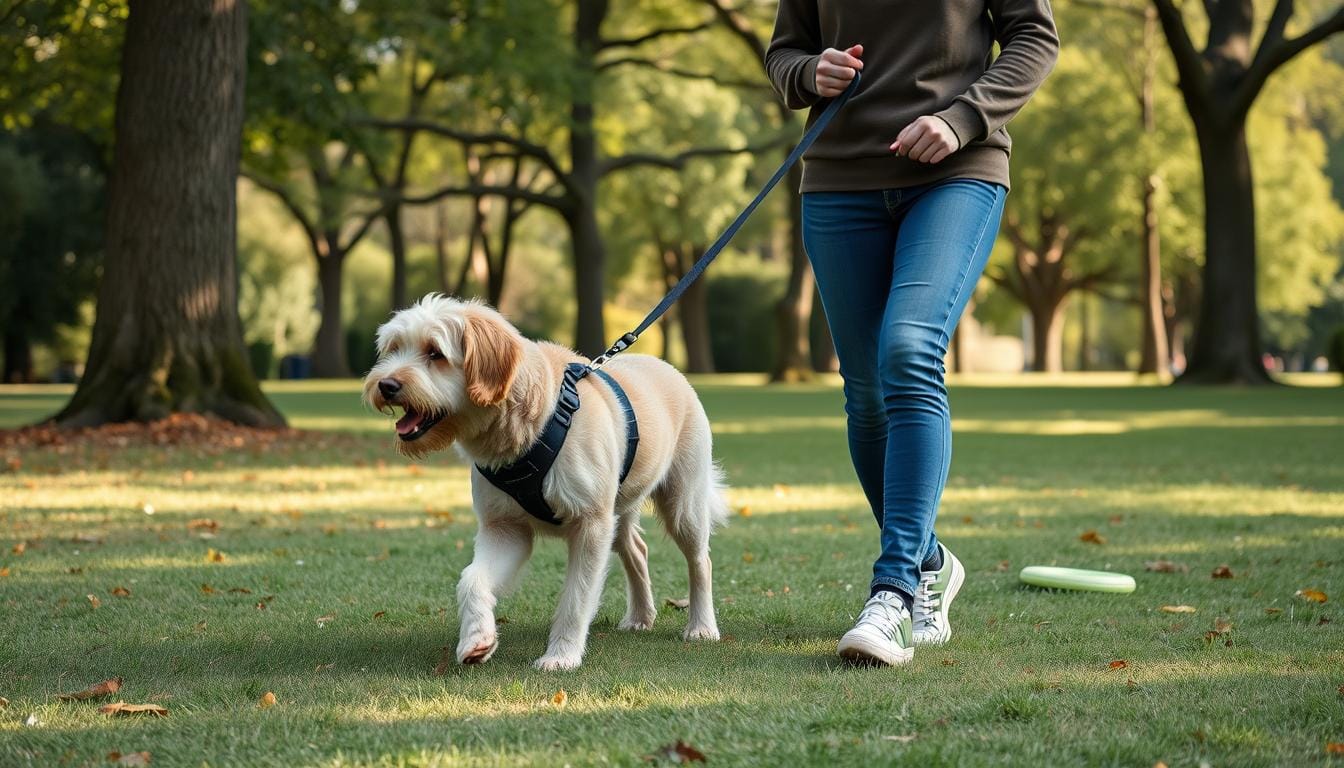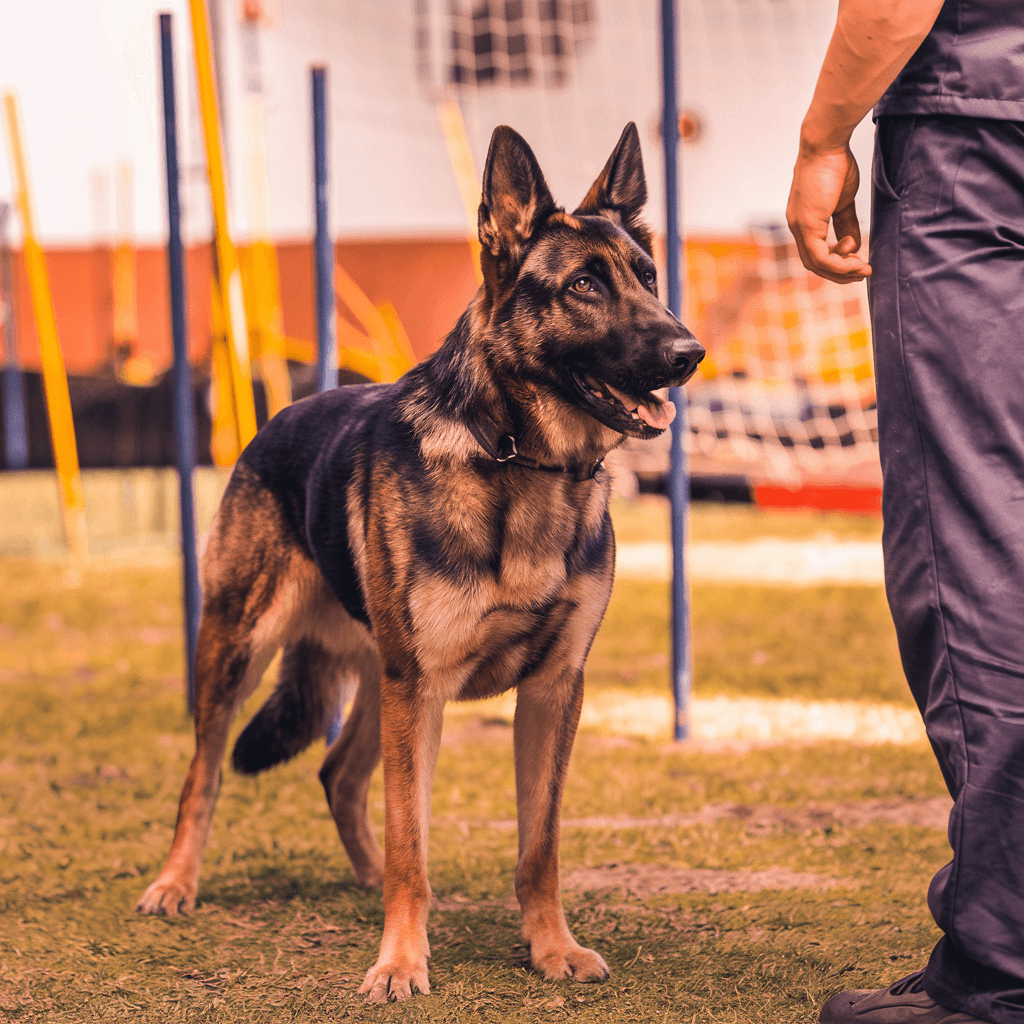Dogs can sense human emotions instinctively. They read our facial expressions and body language. This lets them understand our feelings and form deep bonds with us.
As pet owners, we must care for our dogs’ health. This includes watching their bathroom habits. Blood in dog stool is a concerning issue we need to understand.
Key Takeaways
- Blood in dog stool can indicate various health issues
- Bright red blood suggests lower digestive tract problems
- Dark, tarry stool points to upper digestive tract issues
- Causes range from dietary changes to serious conditions
- Prompt veterinary care is crucial for proper diagnosis and treatment
- Monitoring your dog’s stool helps detect health problems early
Bloody stool in dogs is a worrying symptom. It can be caused by many things, from minor issues to serious health problems. We need to pay attention to this and often seek vet help.
Seeing blood in your dog’s stool can be scary. The color of the blood can tell us a lot. Bright red blood usually means a problem in the lower digestive tract. Dark, tarry stool suggests an issue higher up.
Common reasons for blood in dog stool include infections, parasites, and changes in diet. Sometimes, it can be a sign of serious conditions like inflammatory bowel disease or cancer. That’s why we shouldn’t ignore it.
If you see blood in your dog’s stool, see a vet. They can do tests to find out why and suggest treatment. Early action can greatly improve your pet’s health and recovery.
Understanding Blood in Dog Stool
Blood in a dog’s stool can be scary for pet owners. It’s key to know the types and when to get vet help. Let’s dive into this important part of dog care.
Types of Bloody Stool in Dogs
There are two main types of bloody stool in dogs:
- Hematochezia: Bright red blood in the stool, coming from the lower digestive tract
- Melena: Dark, tarry blood in the stool, often from the upper digestive tract
Hematochezia might mean issues like colitis or inflammatory bowel disease. Melena could point to serious problems like ulcers or cancer.
Importance of Monitoring Your Dog’s Poop
Watching your dog’s stool regularly is key for catching health problems early. It helps spot changes in color, consistency, or blood. This watchfulness can lead to quick treatment and better health for your pet.
When to Be Concerned About Blood in Dog Stool
While a little red blood might not be a big deal, ongoing blood or changes in stool are a red flag. Be worried if you see:
- Blood in stool lasting more than a day or two
- Accompanying symptoms like vomiting, lethargy, or loss of appetite
- Black, tarry stools indicating melena
- Signs of pain or discomfort in your dog
In these situations, get vet help right away. Quick action is vital for tackling the cause and keeping your dog healthy.
Common Causes of Blood in Dog Stool
Blood in dog stool can signal many dog digestive issues. Knowing the possible causes is key to fixing the problem. Let’s look at some common reasons for this symptom.

Gastrointestinal problems often show up as bloody stools. These can be mild or severe. Dogs eating things they shouldn’t or sudden diet changes can upset their stomachs, causing blood in their stool.
Infections are another big reason for bloody stools. Viral, bacterial, or parasitic infections can cause this symptom. Parvovirus, a serious viral infection, is known for causing bloody diarrhea in dogs.
| Cause | Type of Blood | Other Symptoms |
|---|---|---|
| Dietary Indiscretion | Bright Red | Vomiting, Diarrhea |
| Parvovirus | Bright Red | Lethargy, Loss of Appetite |
| Ulcers | Dark, Tarry | Weakness, Pale Gums |
| Parasites | Bright Red or Dark | Weight Loss, Diarrhea |
More serious issues like inflammatory bowel disease, hemorrhagic gastroenteritis, and cancer can also cause blood in dog stool. Physical injuries, like swallowing a sharp object, can lead to bloody stools too.
Stress, certain medications, and eating foreign objects are other factors. Finding the root cause is crucial for treating and managing gastrointestinal problems in dogs.
Identifying Hematochezia in Dogs
Seeing bright red blood in dog stool often means hematochezia. This condition shows bleeding in the lower digestive tract, like the colon or rectum. Let’s look into what this means for our pets.
Appearance and Characteristics
Hematochezia shows as fresh, bright red blood in a dog’s stool. It might look like streaks or make the stool red. Sometimes, blood is mixed with mucus or diarrhea. This makes it different from other digestive problems.
Potential Underlying Conditions
Several things can cause lower digestive tract issues leading to hematochezia:
- Colitis (inflammation of the colon)
- Anal gland problems
- Intestinal parasites like hookworms or whipworms
- Dietary changes or food intolerances
- Trauma from ingesting sharp objects
Finding the cause is key for the right treatment. Watching your dog’s health and stool can help spot problems early.
When Hematochezia Is an Emergency
Any blood in stool is a worry, but some symptoms need quick vet help:
- Persistent vomiting
- Weakness or lethargy
- Pale gums
- Loss of appetite
- Significant amounts of blood in stool
These signs might mean serious blood loss or a big problem. If you see these symptoms with bright red blood, get emergency vet care fast.
Recognizing Melena in Dogs
Melena in dogs is a serious condition. It shows as black tarry stool. This happens when blood from the upper digestive tract gets partially digested in the intestines.
Stomach ulcers, tumors, or blood clotting disorders often cause melena. It’s important to tell melena apart from other bloody stools. This is because melena usually means a more serious problem that needs quick vet help.
Melena is different from bright red blood in stool (hematochezia). Bright red blood usually means a problem in the lower digestive tract. But melena shows bleeding higher up in the digestive system. The dark, sticky stool is a clear sign of this.
“Melena can be challenging to identify, but it’s a critical indicator of potentially life-threatening conditions in dogs,” says Dr. Emma Thompson, a board-certified veterinary internal medicine specialist.
If you see black tarry stool in your dog, act fast. Get vet help right away, especially if your dog also seems tired, won’t eat, or is vomiting. Catching and treating the problem early can really help your dog’s chances of getting better.
| Characteristic | Melena | Hematochezia |
|---|---|---|
| Color | Black, tarry | Bright red |
| Consistency | Sticky, tar-like | Normal to loose |
| Origin | Upper digestive tract | Lower digestive tract |
| Urgency | Immediate vet care needed | Varies, can be less urgent |
Dog Pooping Blood: When to Seek Immediate Veterinary Care
Blood in your dog’s stool is a serious sign that demands attention. We’ll guide you through recognizing when your furry friend needs urgent care. We’ll also talk about the risks of waiting and what to expect at the vet.
Emergency Symptoms to Watch For
Certain symptoms paired with bloody stools signal a dog health crisis. Look out for:
- Lethargy or weakness
- Vomiting
- Pale gums
- Refusal to eat or drink
- Fever
These signs could indicate shock or severe blood loss. They require immediate veterinary intervention.
Risks of Delayed Treatment
Postponing care for a dog pooping blood can lead to serious complications:
| Condition | Potential Consequences |
|---|---|
| Dehydration | Organ stress, electrolyte imbalance |
| Anemia | Weakness, organ dysfunction |
| Organ Damage | Long-term health issues, failure |
What to Expect at the Emergency Vet
During veterinary emergencies, your vet will likely perform:
- A thorough physical examination
- Rectal exam
- Blood tests
- Imaging studies (X-rays or ultrasound)
These steps help diagnose the underlying cause. They also determine the best treatment plan. Quick action in dog health crises can be life-saving.
Diagnostic Procedures for Bloody Stool in Dogs
When a dog has bloody stool, vets use tests to find the cause. They use many tests to figure out what’s wrong and how to fix it.

The first step is a full check-up and looking at the dog’s medical history. This helps decide which tests to run. A stool analysis is often the first test, as it shows if there are parasites or infections.
Blood tests are key too. They show if there are infections, inflammation, or problems with organs. Sometimes, special blood tests are needed to check for certain diseases or blood clotting issues.
Imaging like X-rays or ultrasounds might be used to see inside the dog. These can show things like foreign objects, tumors, or inflammation in the gut.
- Fecal exams for parasites and bacterial infections
- Blood tests to check for infections and organ function
- Imaging studies to visualize internal structures
- Endoscopy for direct visualization of the digestive tract
In some cases, endoscopy is needed. It lets vets see inside the digestive tract and take tissue samples. All these tests help vets find the best way to treat dogs with bloody stool.
Treatment Options for Dogs with Blood in Their Stool
When a dog has bloody stools, vets work on the cause and symptoms. They use a mix of treatments to help the dog get better.
Addressing Underlying Causes
Treatment depends on the main problem. For infections, antibiotics are used. Parasites get antiparasitic drugs. Cancer might need strong treatments. The aim is to fix the main issue.
Supportive Care and Medications
Supportive care is key for dogs with bloody stools. This includes:
- Fluid therapy to prevent dehydration
- Medications to soothe intestines
- Probiotics to restore gut health
Dietary Management During Recovery
Right food is important for dogs recovering. Vets suggest:
| Diet Type | Benefits |
|---|---|
| Bland Diet | Easily digestible, soothes stomach |
| Prescription Diet | Tailored to specific health needs |
| Probiotic-Rich Foods | Restores healthy gut bacteria |
Always follow your vet’s advice for the best care. Most dogs get better with the right treatment.
Preventing Blood in Dog Stool: Tips for Pet Owners
Understanding risks is key to dog health prevention. Young puppies and unvaccinated dogs are at higher risk of diseases causing bloody stools. Parvovirus, for example, can lead to bloody diarrhea and vomiting in unvaccinated puppies. To protect our pets, we must act early.
Pet care advice stresses the importance of vaccinations and parasite prevention. Keeping these up-to-date is vital to prevent blood in dog stool. Regular vet visits help catch problems early, reducing severe complications.
Diet is crucial for gut health. Avoid sudden food changes and keep toxic substances away. Spoiled food can cause bloody stools. A consistent, high-quality diet is essential to prevent digestive issues in dogs.
Essential Prevention Strategies
- Maintain regular vaccination schedules
- Implement consistent parasite prevention
- Provide a balanced, high-quality diet
- Ensure proper hydration
- Schedule regular veterinary check-ups
By following these tips, we can lower the risk of bloody stools in our pets. Most causes of bloody diarrhea need specific treatments, and some can be deadly if not treated quickly. If you see blood in your dog’s stool, get vet help within 24 hours to avoid dehydration and pain.
| Prevention Method | Benefits |
|---|---|
| Regular vaccinations | Protects against parvovirus and other infectious diseases |
| Consistent diet | Reduces risk of dietary indiscretion and gastric upset |
| Proper hydration | Supports overall digestive health |
| Regular vet check-ups | Early detection of potential health issues |
Recovery and Follow-up Care for Dogs with Bloody Stool
It’s natural to worry when your dog has bloody stool. But, most dogs get better with the right care. Let’s look at how to help your dog recover and take care of them after.
Monitoring Your Dog’s Progress
Keep a close eye on your dog’s stool during recovery. Look for better color and consistency. If you see fresh blood, it could mean hemorrhagic colitis.
This condition might need a 24-hour fast and a diet of cooked squash with broth and probiotics. Changes in stool can signal health issues early on.
When to Schedule Follow-up Appointments
Stay in touch with your vet during recovery. Make sure to schedule follow-ups as advised, especially if symptoms last more than 48-72 hours. These visits are crucial for your pet’s care and healing.
If you see dark stools or your dog poops pure blood, get to the vet right away.
Long-term Management Strategies
For long-term recovery, focus on diet and lifestyle changes. Avoid rice for dogs with diarrhea. Instead, try cooked pumpkin or squash with lean meat broth.
Use high-potency probiotics to balance gut flora. Regular health checks and keeping your dog hydrated are also important. They help prevent future bloody stool issues.
















